2002 Spectacular documented reliquary with stigmata relic of St. Padre Pio of Pietrelcina
Large gilt wood glass-fronted reliquary frame housing the first-class ex panno a stigmatibus cruentato (from a cloth bloodied by the stigmata) relics of St. Padre Pio. A very large fragment of the cloth relic is affixed under a portrait of the Saint to a red silk ground profusely decorated with an elaborate gilt paperolle ornamentation and identified in Latin on a typeset cedula label as Ex Panno a Stig. Cruentato S. Pii a Pietrelcina (from a cloth bloodied by the stigmata of Saint Pio of Pietrelcina). On the back, the frame is secured with a crisscrossed red silk ribbon, held in place by four seals of red Spanish wax bearing an imprint of a coat of arms of the Congregation of Missionary Sons of the Immaculate Heart of the Blessed Virgin Mary (Known as the Claretian Missionaries). The relic is accompanied by the original matching authentics document issued by the Postulator General of the Order on June 16, 2002 - on the very day of his canonization.
- ID# 71-RSJPR-6
- Size Frame: 14 1/2 x 12 inches (31 x 37 cm), relic: 20 x 15 mm
- Age ca. 2002
- Origin Rome, Italy
- Materials Wood, silk, paper, Spanish wax
- Price Price upon request
Silver reliquary monstrance with relics of the True Cross and Passion of Jesus Christ
A richly decorated silver reliquary monstrance surmounted by a cross and housing in the central glass-fronted cavity a precious relic of the True Cross of Jesus Christ (SS. Crucis D.N. = the Most Holy Cross of Our Lord) surrounded by five relics of the Christ's Life and Passion: of the Column of Flagellation (Ex Colum. Flag.), of the Thorn from the Crown of Thorns (SS. Coron. Spinae D.N.), of the Empty Tomb of Christ (Ex. Sepul. D.N.), of the Christ's Bandages (ex Fascia D.N.J.C.), and of the Nativity Grotto (Ex Praecepio D.N.). On the back, under a removable cap, the relics are secured by an undisturbed seal of red Spanish wax with an imprint of a coat of arms of Monsignor Jean-Augustin Germain (†), Cardinal Archbishop of Toulouse, France (1899–1928). The reliquary is hallmarked by a French Minerva sterling silver (950/1000) purity mark and a maker's mark of silversmith Favier in Lyon, a famous maker of French liturgical silver.
- ID# 76-RSSR-26
- Size 14 inches (35 cm) tall
- Age ca. 1910s
- Origin Toulouse, France
- Materials Silver, velvet, paper, silk Spanish wax.
- Price Price upon request
-

-

Fancy gold reliquary theca with relics of Christ's Passion - Holy Shroud & Blood
An oval fancy and unique glass-fronted pendant reliquary theca made of solid gold housing two precious relics of the Christ's Passion: the Holy Shroud of Christ and the Veil of the Blessed Virgin Mary soaked in Holy Blood of Christ. Sizable relics are affixed to the ground of red silk surrounded by gold paperolle ornamentation and identified in Latin on a bi-color manuscript cedula labels as De Velum B.M.V. Imbuto Sanguinis Dni Ntri Jesu Christi // De Sancto Sindone in quo involuto fuit corpus Dni Ntri Jesu C. (From the Veil of the Blessed Virgin Mary soaked in Blood of Our Lord Jesus Christ // Of the Holy Shroud in which the body of Our Lord Jesus Christ was wrapped). On the back, the reliquary is secured with a seal of red Spanish wax bearing an imprint with a coat of arms of Bishop Felice Cantimorri O.F.M. Cap. (†1870), Bishop of Parma, Italy (1854–1870). The reliquary is housed in its original leather clad velvet lined case of issue.
- ID# 349-RSCR-15
- Size 42 x 37 mm
- Age ca. third quarter of the 19th century
- Origin Parma, Italy
- Materials 18-karat (750) gold, silk, silver, paper, Spanish wax
- Price SOLD!
-

-

Frame reliquary with a first-class hair relic of the Blessed Virgin Mary
Profusely decorated 19th-century Neapolitan glass-fronted gilt wood shadow-frame reliquary housing an older 18th century silver theca containing an extremely rare Hair relic of the Blessed Virgin Mary. The precious relic is affixed to a ground of red silk decorated with gilt paperolle and silver wire ornamentation and identified in Latin on a manuscript cedula label as Ex Capillis B.V.M. (Of the Hair of the Blessed Virgin Mary). On the back, the reliquary is secured by a wide horizontal silk cord held in place by two seals of red Spanish wax with an imprint of a coat of arms of Monsignor Giovanni Lercari (†1802), Archbishop of Genova (1767–1802).
- ID# 77-RSSR-18
- Size Frame: 9 x 11 inches (22.5 x 27.5 cm)
- Age ca. 1800
- Origin Genoa, Italy
- Materials Wood, glass, paper, silk, silver, Spanish wax
- Price Price upon request
-

Rare documented reliquary theca with relics of the Martyrs of Casamari
Extremely rare large glass-fronted metal reliquary theca housing the first-class Ex Ossibus (of the bone) relics of six Eucharistic Martyrs of Casamari. The relics are affixed to a ground of red silk and identified in Latin on a bi-color typeset cedulae labels. On the back, the theca is secured with a seal of red Spanish wax bearing an imprint of the Postulator General of the Cistercian Order. The reliquary is accompanied by the original matching authentics document issued and sealed by the order of the Postulator General of the Order on March 20, 2025.
- ID# 72-RSJSR-3
- Size 3 x 4 1/4 inches (7.5 x 11 cm)
- Age ca. 2025
- Origin Veroli, Italy.
- Materials metal, glass, silk, paper, Spanish wax
- Price Price upon request
2005 Documented reliquary monstrance with a relic of Maronite St. Charbel Makhlouf, O.L.M
An attractive small glass-fronted gilt-metal reliquary monstrance housing the first-class ex ossibus (of the bone) relic of a Maronite Saint Charbel Makhlouf. Under a portrait of the Saint, a substantial relic is affixed to a red silk ground surrounded by paperole ornamentation and identified in Latin on a bi-color typeset cedula label as Ex Oss. S. Charbel Makhlouf (of the bone of Saint Charbel Makhlouf). On the back, under a protective cap, the reliquary is secured with a seal of red Spanish wax bearing an imprint of a coat of arms of the Postulator General of the Lebanese Maronite Order. The reliquary is accompanied by the matching authentics document issued and signed by the Postulator General on July 24th, 2005 (the day of his Feast).
This item is appropriate for private and public veneration.
- ID# 79-RSJPR-25
- Size 6 inches (15 cm) high
- Age ca. 2005
- Origin Rome, Italy
- Materials metal, glass, silk, paper, Spanish wax
- Price $7,250
2005 Documented reliquary monstrance with a relic of Maronite St. Charbel Makhlouf, O.L.M
Attractive small glass-fronted gilt-metal reliquary monstrance housing the first-class ex ossibus (of the bone) relic of a Maronite Saint Charbel Makhlouf. Under a portrait of the Saint, a substantial relic is affixed to a red silk ground surrounded by paperole ornamentation and identified in Latin on a bi-color typeset cedula label as Ex Oss. S. Charbel Makhlouf(of the bone of Saint Charbel Makhlouf). On the back, under a protective cap, the reliquary is secured with a seal of red Spanish wax bearing an imprint of a coat of arms of the Postulator General of the Lebanese Maronite Order. The reliquary is accompanied by the matching authentics document issued and signed by the Postulator General on July 24th, 2005 (the day of his Feast).
This item is appropriate for private and public veneration.
- ID# 78-RSJPR-25
- Size 6 3/4 inches (17 cm) tall
- Age ca. 2005
- Origin Rome, Italy
- Materials metal, glass, silk, paper, Spanish wax
- Price SOLD!
Documented reliquary theca with first-class hair relics of St. Carlo Acutis
Extremely rare large round glass-fronted metal reliquary theca housing the first-class Ex Capillis (of the Hair) pre-canonization relics of Saint Carlo Acutis. The relics consisting of multiple clippings of hair are affixed to a six-petal flower-shaped paper on a ground of red silk and are identified in Latin on a bi-color typeset cedula label as Ex Capillis Caroli Acutis (Of the hair of Carlo Acutis). On the back, under a protective cap, the theca is secured with a seal of red Spanish wax bearing an imprint of the Postulator General for the Cause of the Beatification of Carlo Acutis. The reliquary is housed in its original case of issue, with a seal of the Postulator General for the cause of Carlo Acutis' canonization. The relic is accompanied by the original matching authentics document issued and sealed by the order of the Postulator General on October 10, 2020 - the very day of his beatification. Please note that, due to its scarcity, this item is not subject to any discounts.
- ID# 42-RSCAR-1
- Size 54 mm (1 1/2 inches) across
- Age ca. 2020
- Origin Rome, Italy
- Materials metal, glass, silk, silver, paper, Spanish wax
- Price Price upon request
Reliquary with first-class hair relic of St. Bernadette Soubirous
An attractive round glass-fronted gilt bronze reliquary florall ornamentation housing first-class ex capillis (from the hair) and second-class ex indumentis (of the dress) relics of St. Marian-Bernadette Soubirous. Precious relics are affixed to a silk ground and identified in Latin as S.Maria // Bernadae. On the back, behind a removable cap with a foldable stand, the theca is secured with a perfectly preserved seal of red Spanish wax bearing an imprint of a coat of arms of Fr. Patrice Flynn († 1970), Bishop of Nevers, France (1932-1963).
- ID# 80-RSSR-1
- Size 50 mm (2 inches) across
- Age ca. 1960s
- Origin Nevers, France
- Materials bronze, glass, paper, Spanish wax
- Price Price upon request
French reliquary monstrance with relics of Saint Stephen, the Protomartyr
A richly decorated gilt brass reliquary monstrance decorated by multicolored crystals and housing in the central glass-fronted cavity a first-class ex ossibus (of the bone) relic of Saint Stephen, the Protomartyr. A substantial relic comprised of multiple bone fragments is arranged in an X shape on the ground of red velvet surrounded by gilt paperolle with small pearls and identified in French on typeset cedula label as S. Etienne, 1-er M. (Saint Stephen, the First Martyr). On the back, under a removable cap, the relics are secured by an undisturbed seal of red Spanish wax with an imprint of a coat of arms of an unidentified Roman Catholic Archbishop.
- ID# 79-RSSR-125
- Size 14 inches (35 cm) tall
- Age ca. 1880s
- Origin France
- Materials brass, crystals, velvet, paper, silver, pearls, Spanish wax
- Price Price upon request
-

The web site showing only a sample of our entire inventory, if you don't see what you are looking for, please contact us.

Learn about our Unconditional Lifetime Guarantee and No Questions Asked 30-day return policy.





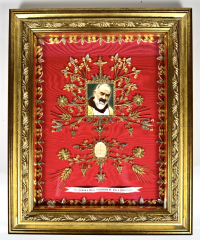
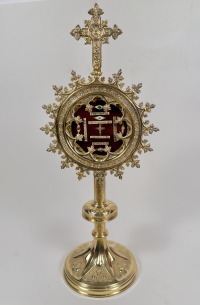
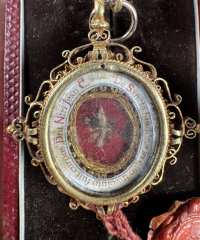
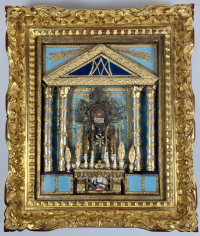
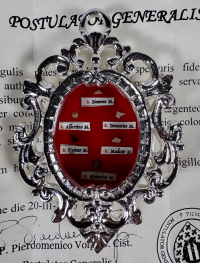

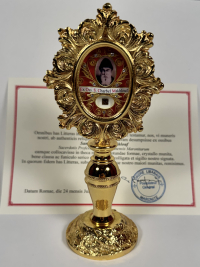
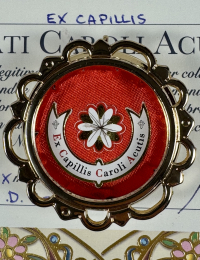

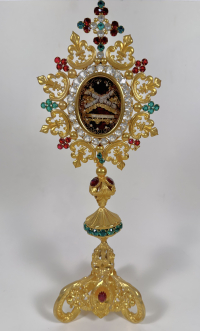

 Поменять язык на русский
Поменять язык на русский 